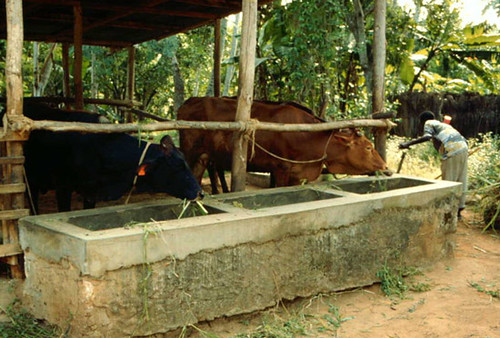What’s needed is to make better use of cow manure to fertilize the country’s impoverished soils.
Is Uganda outgrowing its popular zero-grazing dairy model? Reports from a recent research study suggest that Ugandan policymakers may want to revisit their policies supporting the country’s booming dairy sector to sustain increasing yields of smallholder mixed crop-and-dairy production over the long term.
Before the 1980s, milk production in Uganda occurred largely in two contrasting production systems. There were the large, mostly government-owned, commercial dairy farms located in the wetter parts of the country on which exotic and cross-bred dairy cattle were kept and grazed on natural pastures. Then there were the pastoralists, who kept large numbers of local cattle under traditional management systems in the drier eastern and northeastern parts of the country.
From the mid-1980s, development agencies in Uganda began introducing zero-grazing systems, in which high-yielding genetically improved cows (pure or cross-bred with local cattle) are kept in stalls and fed with fodder cut and carried to them daily. These more ‘intensive’ dairy systems were promoted among Ugandan farmers along with training on managing dairy breeds and growing fodder. This gave many smallholders an incentive to buy exotic dairy cows or to upgrade their indigenous cows by cross-breeding them with exotic stock. Some of Uganda’s small farmers adopted strict zero-grazing practices while others combined grazing paddocks with stall feeding, a hybrid dairy production system that came to be known as ‘semi-intensive’.
As a result, there has been a steady increase over the last two decades in the numbers of improved dairy cows in Uganda’s national herd with concomitant increases in national milk production yields, smallholder contributions to national milk production, dairy’s contribution to the national economy, and per capita milk consumption.
Ugandan dairy support
Sixteen years ago, in 1992, the government launched a ‘Milk Master Plan’ to improve (simultaneously) rural incomes, farm living standards, national self-sufficiency in milk production, and yields of surplus milk for export. With the liberation of the sub-sector in 1993, when the government’s monopoly on milk processing was broken, many medium and small-scale private milk processors emerged on the scene. To realize the objectives of its ‘Milk Master Plan’, Uganda in 1998 established a Dairy Development Authority.
With the rapid rise of dairying among smallholder farmers, people began to question whether intensification was the best option for Ugandan farmers and whether these mixed dairy-crop production systems could be sustained.
To respond to these concerns, an in-depth study funded by the Danish International Development Agency (DANIDA) was carried out between 2001 and 2005 by the Ugandan National Agriculture Research Organization (NARO), Makerere University, the International Livestock Research Institute (ILRI) and the Danish Institute of Agricultural Sciences (DIAS).
The study, focusing on dairy economics and nutrient cycling, was carried out in three districts—Mbarara, in southwestern of Uganda; Masaka, in southern Uganda; and Jinja, in the southeast, which is much smaller than the other two districts but with the highest human population.
Results of the research study indicate that Uganda may be ‘outgrowing’ its successful, and ever popular, zero-grazing model. The results show that Uganda’s booming dairy farming is profitable regardless of the level of ‘intensification’ that farmers employ through use of feeds and other inputs. This finding suggests is that a high-input / highly intensified production system like Uganda’s popular and heavily policy-supported ‘zero grazing’ system is not necessarily the best option for all of the country’s small-scale crop-and-dairy farmers. Even the country’s most progressive dairy farmers, who have adopted zero-grazing en masse, may want to revisit their choice of production system to sustain their crop as well as dairy production over the long term.
Another finding of the study is that all of Uganda’s dairy farmers, whether intensive, semi-intensive or agro-pastoral, tend to under-use their animal manure as organic fertilizer for their crop fields. The study found the quality of the soils on Uganda’s mixed dairy-crop farms already below a level considered critical for crop production and continuing to drop. This deteriorating situation is fast eroding the long-term sustainability of these farming systems; if nothing is done, food insecurity and poverty in the country are likely to worsen. This is despite these farmers having adequate amounts of manure from their dairy cows to use as fertilizing soil amendments. It is likely that Uganda’s dairy farmers are under-using their livestock manure to fertilize their crop soils because they lack the labour needed to save, transport and apply the manure.
|
RESEARCH RECOMMENDATION:• This study revealed how surprisingly little research can yet tell us about the advantages and disadvantages of African farmers applying livestock manure as fertilizer on their mixed-production farms. We still lack, for example, sufficient comparative data on its effects on small-farm economics, nutrient cycling, practicability, and labour trade-offs.
• We don’t yet know enough about these matters to recommend best-practice manure management and application methods for Uganda’s many small dairy producers. We ought to. We need to research manure management in the context of Africa’s complex small farming systems so that we can offer the continent’s farmers recommendations validated by research. |
Download the Research Report: http://hdl.handle.net/10568/257
Download the Research Brief: http://hdl.handle.net/10568/3808
Partners:
Ugandan National Agriculture Oragnization (NARO)
Makerere University
Danish Institute of Agricultural Sciences (DIAS)
Further Information Contact:
Isabelle Baltenweck
Scientist
International Livestock Research Institute
Nairobi, Kenya
Email: i.baltenweck@cgiar.org
Telephone: +254 (20) 422 3000
OR
Sarah Mubiru
National Agricultural Research Organization (NARO)
Kampala, Uganda
Email: smubiru@naro-ug.org


Kindly mail me the full article, I am in process of proposal development for the above mentioned course on zero-grazing in Hoima District.
Dear Perez,
I have updated the link in this article and you can now download the related research report and brief.
Paul.
zero grazing is the way to go since is increasing at a highest rate yet the land is static,therefore zero grazing will make people survive through milk production for home consumption and selling as well.